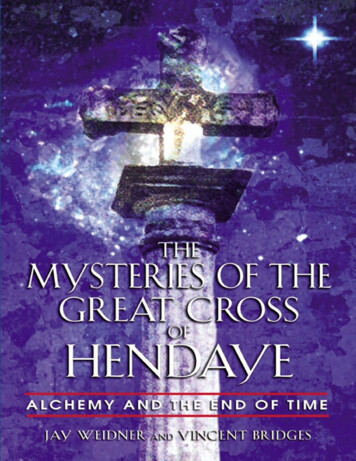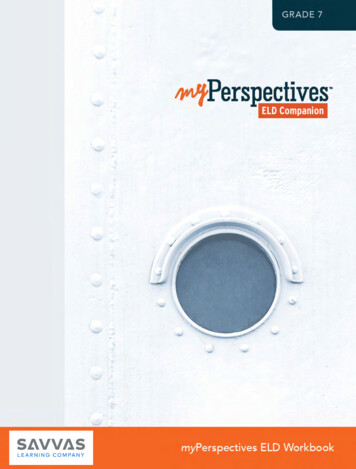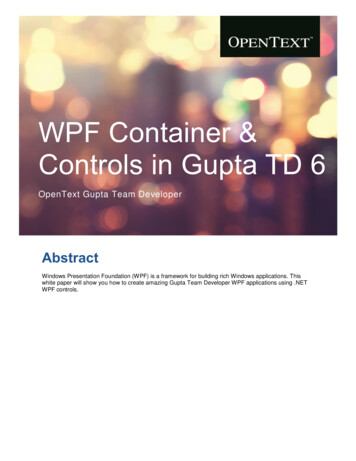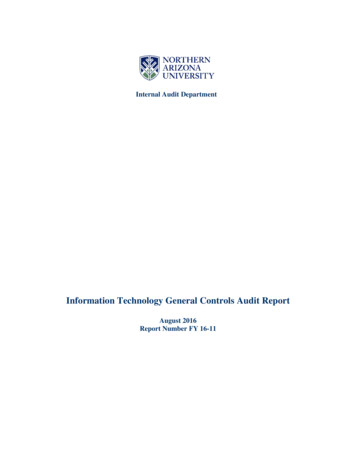
Transcription
The sphinx protects and controls science. Jean-Julien Champagne’s frontispiece for LeMystère des cathédrales, 1926.
You, who are thirsty, come hither: if, by chance, the fountain fails,The goddess has, by degrees, prepared the everlasting waters.TRANSLATION BY FULCANELLI OF AN INSCRIPTION ON THESTATUE OF MAÎTRE PIERRE, WHICH STOOD ON THE PARVIS OFNOTRE-DAME-DE-PARIS UNTIL ITS REMOVAL IN 1748For The Brotherhood of Heliopolis,the Children of St. Vincent,and the Knights of the Chateau Marie;may this Work be a Beacon on the Path.I would like to thank my teachers—you know who you are—my parents, George and Ruth Bridges,and most especially my wife, DARLENE,without whom none of this would have been possible.VINCENTDedicated to the wisdom of the Great Traditionand the servants of the Work.Thanks to Phil Lipson, Jerry Redfern, and John Mullet at theSeattle Metaphysical Library.Thanks also goes out to John Major Jenkins, Robert Lawlor,Janie Noble, Juris Kalnins, and Chris Knab.A special thanks to my late grandmotherMary Magdeline Weidner and my wife, partner,friend, and teacher, Sharron Rose.JAY
ACKNOWLEDGMENTSWith a project of this size, there are many people to thank. Thanks are duefirst of all to our artist, Darlene, who provided all the line drawings anddiagrams. Without her skill, patience, and commitment this book would nothave been possible. We would also like to thank The Tate Gallery, London,for permission to use Max Ernst’s painting on page 18.Thanks to Richard Buehler of the Brotherhood of Life for permission touse illustrations and quotes from the English version of Le Mystère and toKevin Townley of Archive Press, who let us read the translation of Dwellingsas it was finished and confirmed the importance of the Cube of Space.Thanks to Robert Lawlor for correcting some misperceptions early on and toDr. Paul LaViolette, who kindly let us use illustrations from his work EarthUnder Fire and encouraged us to see alchemy through an even larger lens.Dr. Alberto Villoldo, Dr. Juan del Prado, and William Sullivan deservethanks for pointing us so directly to Peru as does J. M. Allen for guiding us toAtlantis in the Andes. Thanks are also due to our many local guides andfriends in the far corners of the earth where our research led us: Mlle. MarieYavanna de Rokay in Paris, Juan-Jesus de la Vega in Cusco, Mohammed ibnAli in Luxor, Su Ling in Lhasa, and the mayor of Pharping, and his ricebrandy, in Nepal.As this book grew over time, many people had the opportunity to readparts of it and supply some helpful comments. Foremost of these http://groups.yahoo.com/group/priory-of-sion). Thanks to Stella, Nick, Tim,Andrea, Steven, Alice, and all the rest for their unflappable scholarship intime of need. Also thanks to Moira Timms, John Major Jenkins, and SteveCrockett for sharing their research and thereby contributing to our own. Andthanks to elfsbeth for just being a fan.Finally, major thanks are due the team that helped produce this newedition. Dr. Terri Burns lent her invaluable research skills to the job oflocating sources and references in libraries on three continents. Ourcopyeditor Cannon Labrie performed wonders; being edited by someone ofhis skill and erudition was a pure pleasure. Cannon forced us to deal with thehard questions, and the book is far better for his input. Also at Inner
Traditions, thanks are due to Jon Graham for remembering a two-year-oldmanuscript, Jeanie Levitan for her diplomatic skills and grace under pressure,and the entire production staff for solving riddles of style involving names inmany languages and from different centuries. A sweeping tip of the Phrygiancap to you all . . .On a personal note, I would like to especially thank my coauthor, JayWeidner, for graciously allowing me to take the lead role in reworking thisnew edition. Any errors in the text are mine, therefore, not Mr. Weidner’s.VINCENT BRIDGES
CONTENTSAcknowledgmentsPREFACE Hendaye: A Monument to the CosmosINTRODUCTION The Politics of Secrecy: Fulcanelli and the Secret of the End of TimePART ONEFulcanelli and the Secret of AlchemyONEThe Fulcanelli MysteryThe Apocalypse, the Lost Generation, and the Rediscoveryof AlchemyLe Mystère des cathédrales, Alchemy, and SurrealismA New ChapterThe Fulcanelli LegendThe Cross at HendayeA Lodestone of Pure WeirdnessTWOThe Secret of AlchemyThe Alchemical Meme and Secret SocietiesEgypt: Isis and HorusThe Underground Stream: From Egypt to the Middle AgesThe Underground Stream: From the Black Death toFulcanelliThe Threefold TransformationTransformations and TranscendencePART TWOEschatology and Astronomy
THREEGnostic EschatologyThe Gnostic Return: Isis and Mary the AlchemistThe Alchemical Eschatology of ChristianityRevelation, the Antichrist, and ChiliasmConstantine and the Orthodox ApocalypseFOURThe Ancient Illuminated AstronomyHebrew IlluminismThe Teli, the Cycle, and the Heart: Serpents in the SkyThe Kaaba, the El Most High, and the Covenant ofAbrahamIslam: Sanctuary of Sacred SciencePART THREEThe Gothic Renaissance and the Holy GrailFIVEThe Hermetic Pope and the Knights TemplarThe Alchemical Transmission and the Recovery of the WestThe Alchemical Pope and the Creation of the MillenniumPeter the Hermit, the First Crusade, and the Rock of ZionThe Secret of the Knights of the Temple of SolomonSIXGrail Knights, Perfecti, and the Illuminated Sages of ProvenceThe Hermetic GrailThe Grail in ProvenceThe PerfectiThe Stone of the WiseElijah, Eschatology, and the Underground StreamSEVENTemples of the Cosmos, Cathedrals of the GoddessThe Hermetic Cathedrals“Bright Is the Noble Work . . .”The Gothic Cathedrals of Our Lady
The Stone That Fell from Heaven, Black Virgins, and theTemple of the GrailThe Philosophers’ ChurchPART FOURThe Mystery of the CathedralsEIGHTThe Grand Hermetic Theme and the Tree of LifeFulcanelli’s Notre-Dame-de-ParisOur Hermetic Tour Guide Poses a ConundrumSolving the ConundrumSaint Marcel’s DragonThe World Tree and Astro-AlchemyNINEFulcanelli’s Tree of Life and the Mystery of the CathedralsLe Mystère as the Tree of LifeThe Alchemy of Light: Fulcanelli’s KabbalahPART FIVEHendaye’s Message: The Season of Catastrophe and the Place of RefugeTENThe Mystery of the Great Cross at HendayeA Forgotten CrossPrecessional Mythmaking and an Enigmatic Altar to theGod of TimeVishnunabhi, the Mother, and the Hermetic Brotherhood ofLuxorThe Mystery of the Stone AltarELEVENThe Message of the Great Cross at HendayeTriangulating the Myth and the MessageDeciphering the CodeThe Monument Speaks: The Season of the ApocalypseThe Philosopher’s Stone and the Quality of Time
TWELVECatastrophe and RefugeCosmic Superimposition: Wilhelm Reich, Orgone, and theCenter of the GalaxyMessages from Many SourcesEarth under Fire: The Double Catastrophe RevealedThe Inscription’s Message and the Place of RefugeA Sign Pointing toward PeruAtlantis in the AndesThe Navel of the WorldIncan Caves and the Cross at UrcosPART SIXThe Great Mystery: Illuminated Masters, Apocalyptic Refuges, and MythicTimeTHIRTEENFrom Atlantis to ShambhalaThe Cross and the Myth of TimeLooking East: A Refuge in the HimalayasPadmasambhava and the Temple of the CosmosShambhala and the Wheel of TimeFOURTEENEPILOGUEAlchemy and TranscendenceFulcanelli RevealedAPPENDICESAPPENDIX AFulcanelli on the Green LanguageAPPENDIX BThe Emerald TabletAPPENDIX CNotes on Mount ZionAPPENDIX DTree of Life Symbology in Le Mystère des cathédralesAPPENDIX EThe Cyclic Cross of HendayeIndex
FootnotesNotesBibliographyAbout the AuthorAbout Inner TraditionsBooks of Related InterestCopyright
PREFACEHENDAYE: A MONUMENT TO THE COSMOSAny earnest inquiry into the reasons for human existenceeventually comes up against the two most difficult questions of all,“Who are we?” and “Why are we here?” Despite today’s advancesin science and technology, these two questions have remainedunanswered. Focused as it is on the physical, modern science can show ushow we got here and it can show us of what this world is made, but it cannotsatisfactorily answer these fundamental metaphysical questions about themeaning of life.As a result of this gap in our knowledge, human beings appear to be caughtin a delusion, unaware of their vast potential. So where do we go to findanswers to life’s ultimate questions? Many have sought insight in the textsand teachings of the world’s sacred traditions, only to find that many of theseancient traditions are either partially or wholly lost or nearlyincomprehensible. These once vital and significant traditions have left behindfragments of knowledge that, at least, seem to point to the solutions, but theseanswers are often vague, difficult for modern minds to grasp, or elseshrouded by the veils of time and cultural changes. Our own Western esotericalchemical tradition, once guided by a deep and profound understanding ofthe intimate relationship among human beings, nature, and the cosmos, hasbeen on its last legs for centuries.Because of the vast changes in culture, language, and perception that havetaken place since the Industrial Revolution, any serious study of the past ismade much more difficult. The Industrial Revolution caused a seriousdisruption in Western culture that cannot be overemphasized. The rise of themachine and mechanism changed the way we think, the way we see the past,and the way we view our ancestors. No longer are our ancestors valued fortheir wisdom or knowledge. As the mechanized Age of Iron envelopedWestern civilization, we almost lost our spiritual heritage as well.From the time of the Inquisition onward, many of our most sacredteachings were rooted out and expunged from the dominant view, creatingthe continuing drama that we call European history. “Europe’s inner demons”
is how historian Norman Cohn characterized the spiritual and historicalnightmare that has haunted Europe for centuries. The result of the conflict,madness, and destruction that have marked modern European history was thealmost complete loss of the mythologies, wisdom, and profound knowledgethat sustained the West through the Middle Ages. This loss was the problemthat Fulcanelli attempted to correct when he wrote his masterpiece LeMystère des cathédrales, or Mystery of the Cathedrals, in 1926. By thebeginning of the twentieth century, the secret of alchemy had become lost inthe well of time. Replaced by rampant speculation, obscure texts, and manyfailed attempts to turn lead into gold, the once deeply spiritual science ofalchemy was headed for the dustbin of history. With one book by Fulcanelliall of that would change. The twentieth century’s entire intellectual andartistic interest in alchemy was reawakened and energized by the appearanceof Le Mystère. In writing it, Fulcanelli sought nothing less than to resacralize,relegitimize, and reinvigorate the entire Western esoteric tradition. Hepromised that through an in-depth study of its pages, any sincere andconscientious student would begin to comprehend what is referred to in thelore as “the secret language of the birds,” the subtle language of spirit that“teaches the mystery of things and unveils the most hidden truths.” From thisunderstanding, a profound inner awakening would begin to take place.Through a careful and exquisite unveiling, Fulcanelli, himself an adept ofthis Western lineage of transmission, provides readers with the keys tounlock the doors to the sacred mysteries that lie at the root of the alchemicalarts. These mysteries include not only the “science of light and time” but alsothe path toward communication with living matter itself and with the DivineIntelligence presiding over our galaxy.In addition to its profound restatement of the Western esoteric tradition,which is significant enough, perhaps the single most important aspect of LeMystère was the single chapter added to the 1957 edition of the book. Thischapter, called “The Cyclic Cross of Hendaye,” discusses a simple yetmysterious monument located in southwestern France that Fulcanelli dates tothe middle of the seventeenth century. The monument’s few inelegantsymbols reveal that not only was it built by a “master mason,” but that itscreator possessed a surprising amount of arcane knowledge. It also proved,and Fulcanelli echoes this, that there was, and possibly still is, a group ofpeople, a secret society, if you will, that knows the very secret of time andlight, which secret is the basis of all true alchemy. More surprising, Fulcanelli
tells us that this secret society was still active as few as three hundred andfifty years ago.The message of the cross at Hendaye is that time is not a mystery, that thesecret of time itself could be understood. Like a river, time has many bendsand turns, many tributaries and creeks, but it is possible that time, like a river,can be mapped. And when the map of time is properly understood, themystery of the future disappears. In addition to this remarkable revelation, thesymbols and teachings encoded in the cross at Hendaye offer us a newunderstanding of the cosmos, especially with regard to the center of theMilky Way Galaxy and its effect on us.Finally, the cross at Hendaye reveals that its maker understood the greatalchemical experiment that occurs at the end of time. The secret alchemicalMercury that rules the primordial essence of life itself is enlivened andinvigorated during the time span indicated by the cross. Practical alchemistswould know, just by examining the symbols on the cross at Hendaye, when toperform their most secret experiments. As Fulcanelli intimates, this secretexperiment is nothing less than the creation of a Golden Age.History appears to be a long initiation into the mysteries of the universe.As with any initiation, attention to ethical standards, clear communication,and right action are the necessary ingredients for the initiation to take place.When the initiation is over, we shall know who we are and why we are here.The great return of the alchemical tradition is the road back to a sciencebased on timeless spiritual principles. Alchemy is the science of humandevelopment, the art of turning glass into light and lead into gold. But as anytrue adept will tell you, these are merely metaphors for deep and secretmysteries of the spirit. As we in the West reestablish contact with theprimordial source of life and wisdom, we shall shed the veils that conceal theprofound nature of ourselves and this planet. With the return of this grandand glorious tradition we shall once again understand who we are and whywe are here. The main rule of alchemy, that “only like can become like,” willbe recognized for what it truly means. As the atoms that make up the fleshand bones of our bodies were once thriving inside the hearts of stars nowdead, so will our consciousness one day occupy future stars. Human beingsare the stuff of stars endowed with consciousness. We are the seeds of thecosmos. It is our true heritage to take our place in the order of the universe.That is the real promise of alchemy, Fulcanelli, and the Cyclic Cross atHendaye.
JAY WEIDNER
INTRODUCTIONTHE POLITICS OF SECRECY: FULCANELLI ANDTHE SECRET OF THE END OF TIMEFor me, it all started a few years ago when Jay Weidner asked mewhat I thought of Fulcanelli. Being full of my own opinions andsure of their validity, I gave him the quick rundown on what Iknew: “Mysterious twentieth-century alchemist featured inMorning of the Magicians and therefore somewhat suspect. Colin Wilsonsuggests that he is another alchemical con man such as Cagliostro or St.Germain.”Jay laughed and suggested that I read Mystery of the Cathedrals,Fulcanelli’s first book, and The Fulcanelli Phenomenon, by Kenneth R.Johnson. When I did, I realized that the books described one of the mostfascinating puzzles of all time. Alchemy was certainly a key part of themystery. At the heart of this puzzle, however, lay something even stranger—ancient knowledge of the location of the center of our galaxy and from thatknowledge a way to estimate the date of a celestial event of eschatalogicalmagnitude. The sophisticated astronomical culture of the Maya consideredthis event to be the end and beginning point of time itself. After the fall of theancient cultures in the Old World, simple knowledge of the event became thesecret possession of the initiated elite.As the mystery unfolded and the puzzle appeared before us, Jay and I wereastonished that no others seemed to have seen this. And then we realized thatof course they had. We had stumbled on the big secret, the grand MacGuffinof human history. All of humanity’s psychodramas seemed to have the secretat their core, even when knowledge of the secret was limited to the initiatedfew. From this perspective, what we had been taught to regard as historylooked a lot like the residue of a millennia-long global conflict over controlof the secret and its ramifications. As we researched this story, three maincurrents or groups emerged. These currents, perhaps better described ascollective viewpoints, we defined by their relationship to the secret.The first group, which we shall call the Priest-Kings, believed it had theright to possess the secret based on ancient traditions and bloodlines. In
contrast to this basically Osirian position, and making up the second group,were the nihilistic Sethians, who wanted to possess the secret exclusively andwere willing to destroy everything to get it or to keep anyone else fromgetting it. The ancient myth of Osiris, the rightful king, whose power isusurped by his evil brother, Seth, and then avenged by his son, Horus, echoesthis struggle over control of the secret. The myth retains its power eventoday, as witness the success of Disney’s The Lion King.In between these extremes, in some moral and social gray area, are theOpportunists, the group that is willing to own the secret, use the secret,control the secret, or whatever it takes to provide for its own wealth, power,ego gratification, and so on. We have few mythological metaphors for thisgroup because it is recent, developing only in the last two thousand years. Allthree of these groups are mutually antagonistic, yet interdependent. None ofthem wants the others to gain complete control, yet none can gain it alone.But most of all, none of them wants to share information with uninitiatedoutsiders.Someone in the late seventeenth century, however, built an enigmaticmortuary monument in the quaint Basque coastal town of Hendaye. Morethan 250 years later, an equally mysterious author, Fulcanelli, would add anew chapter to his thirty-year-old book claiming that the “Cyclic Cross ofHendaye” was the ultimate expression of “chiliasm” (a belief in the LastJudgment as a literal end of time) as well as a description of the Great Workof alchemy. These simple facts point to several interesting conclusions.Not only have the initiated few survived for centuries, right down into ourown time, but apparently some of them wanted to reveal the secret as well.Interesting as these conclusions are, they force us to an even more dramaticone. If one of the initiated gave away the secret in 1957, it could only havebeen because the secret was in danger of being lost, or, even worse, co-optedand distorted. By 1957, the balance of power had shifted, and the nihilisticSethians scented final victory in the Cold War breeze.To understand the importance of Fulcanelli’s message, we must rememberthat by the late 1950s it must have seemed, to those in the know, thatsomething fundamental had changed. The Sethians and the Opportunists hadfinally learned to cooperate. The Priest-Kings, with their mysticalconnections, had almost been destroyed. The Sethians were in the process ofconvincing the Opportunists of the need for mass suicide by way of an atomicwar. The secret of the end of time and the possible transformation of the
human species were in danger of being lost, forgotten, or changed beyondrecognition.The value of Fulcanelli’s revelation can be seen in the amount ofmisinformation and distortion that obscures any discussion of the person or ofhis work. Even Johnson’s Fulcanelli Phenomenon, the only major work onthe subject in English, reads like a mass of purposeful confusion, which isepitomized in its penultimate chapter, a bizarre science-fictional analysis ofthe Cyclic Cross by someone called “Paul Mevryl.” From the informationpresented in this work, we might be forgiven for thinking that, while not quitea con man, Fulcanelli and his disciple Canseliet were perhaps as deluded ordelusional as any other alchemist of the past.And yet, when we read Mystery of the Cathedrals, we find no confusedcharlatan rambling on about imagined esotericisms. We come face-to-facewith one of the most penetrating intellects of the twentieth century. Thepower of this intellect appears, especially in Cathedrals, to be driven by anurgent need to communicate the outlines of a great mystery. In delineatingthis mystery, Fulcanelli tried, by piling up images and allusions, to suggest avast initiatory process at work in human history. At the core of the book,though, is a question.The first edition, published in 1926, ended with the question unanswered,although a glimpse of the answer can be seen embedded within the brilliantsynthesis of ideas at the heart of Mystery of the Cathedrals. By the time ofthe second edition, 1957, the question had been answered. Fulcanelli decidedto reveal the secret of the end of time. When the book was reprinted, headded a new chapter that was more about chiliasm than alchemy and in whichhe sketched out the ground rules for solving the puzzle of the Cyclic Cross ofHendaye.Five years later, Morning of the Magicians, by Pauwels and Bergier,became an international bestseller. In many ways, this was the start of theNew Age movement and the beginning of the process of obscuring Fulcanelliand his work. This occulting would continue in numerous books and articlesabout enigmatic events and unsolved mysteries by Colin Wilson and others.The Fulcanelli Phenomenon, published in 1980, compounded the problemand convinced most readers that any mystery having to do with the cross ofHendaye was simply paranoiac delusion. Perhaps that’s what the book wasintended to do.And here matters remained until Jay and I rashly and naively decided to
solve the puzzle. Like some esoteric Tar Baby lurking at the astral crossroadswaiting for a couple of happy-go-lucky Brer Rabbit–type researchers to comealong, the monument’s mystery proved irresistible once touched. We werestuck with it—all the way to the briar patch.The quest took us from Elberton, Georgia (where a mysterious R. C.Christian has built a monument to the end of time), to France, Peru, andEgypt. Along the way, we were aided by so much synchronicity andcoincidence that we eventually concluded there was a fourth current or groupat work, behind the scenes, that actually wants the secret revealed to as manypeople as possible. This Free Will party, as we jokingly called it, seemed tobe guiding our research and at times manipulating events.That Jay and I got together at all was the result of complex personalsynchronicities that spanned decades and ended with us both, for the mostunlikely and absurd reasons, being in Boulder, Colorado, during the fall of1997. As we started out almost as far apart geographically as it is possible tobe and still be in the United States—I live in central North Carolina and Jaylived at that point on the coast of Washington in the Pacific Northwest—Boulder was like meeting halfway.Deciphering the monument’s message turned out to be the easy part. Oncewe had the message, deciphered in one rush of comprehension on a stormyHalloween night high in the Rockies, our emphasis shifted to finding outwhat it meant. The monument pointed to a specific time period, theintersection point of several celestial cycles, and we wanted to know exactlywhy Fulcanelli had described this event as a “double catastrophe” in whichthe northern hemisphere would be tried by fire—Judgment Day, in otherwords.And that’s where the real synchronistic fun and games began. Books,necessary volumes that we needed to see but didn’t even know existed, beganto appear: Once an extremely rare book miraculously turned up after accesswas denied us, and once, even more synchronistically, a key book was leftbehind in a smoking lounge at Heathrow Airport for us to find. Beyond thesource texts, authorities began to show up—a local Boulder publisherannounced a new edition of Fulcanelli’s Dwellings of the Philosophers andlet us read the translation as it proceeded. Dr. Paul LaViolette arrived for aconference and redirected our whole perspective. William Sullivan, JohnMajor Jenkins, Dr. Alberto Villoldo, and Dr. Juan del Prado appeared atcrucial moments and added their pieces of the puzzle.
Perhaps the most prominent synchronicity of all centers on the image ofthe rose-cross ankh. Several years before Jay and I met, I had every rosecross ankh in the Coptic Museum in Cairo photographed in an attempt totrace the idea in early Christianity. By coincidence, we discovered in Arlesand at the Louvre a series of rose-cross ankhs that would have beencompletely mysterious without the images from the Coptic Museum.Fulcanelli’s use of the word chiliasm gave us a clue to their meaning.Chiliasm is a Gnostic conception of the Christian Last Judgment in which anew existence, a new spiritual reality, supersedes our flawed common realityat the end of time. Many scholars, such as Elaine Pagels and Ioan Couliano,consider chiliasm to be the most sophisticated of the many first-centuryeschatological perspectives. Chiliasm was never declared heretical andsurvived as a belief in the Coptic Church. The ankh, symbol of eternal life,with the blooming flower at its center, represented the chiliastic ideal of theSecond Coming as a renewal of all life.The Egyptian origin of this concept suggested to us the antiquity of itsinsight. Following this thread, we found evidence that alchemy, as we haveknown it historically, is actually a demonstration of the transmutationalphysics at work in the galactic core, and was apparently know to the ancients.The inner core of alchemy appears in this light as the ability to apply thephysics of creation to the task of personal immortality. And with thisknowledge, of course, would come the ability to survive the doublecatastrophe.If the secret, the grand MacGuffin of human history, is the ability to chartthe celestial timing of the eschatological event, then the only seriousquestions become: “Is it true?” and “Can we survive?”After compiling and sifting through a huge amount of research, we candefinitively answer the first question: Yes, it’s true. We are about to receive acosmic wake-up call from the center of the galaxy.As for the second question—Will the celestial event bring extinction orenlightenment?—the answer remains open. The existence, however, of afourth current, the Free Will, share-the-information party, suggests that thereis an answer.Perhaps human evolution, once certain physical parameters, such as thesize of the skull versus the width of the mother’s hips, are reached, becomesan internal, personal process of initiation. Defining this personal process is agalactic wave of change that brings the opportunity of transformation to those
who have reached the required level of internal transmutation. To those whohaven’t reached this level, perhaps it brings madness and destruction, perhapseven a global catastrophe, in its wake.Because of the politics of secrecy surrounding the knowledge of thisoncoming celestial event, we, as a culture, have been blissfully unaware of itsapproach. Eschatological speculations long ago became the property ofcranks and fringe religions. Science has given the appearance of abdicatingits responsibility for interpreting its own findings. And yet, the knowledge,the gnosis, survived the secrecy and persecution and is now on the verge ofbecoming once again a common cultural perspective.The fourth current, the Free Will party, might just have won out after all.VINCENT BRIDGES
It has long been believed that the Gothic cathedrals were secret textbooks of some hidden knowledge;that behind the gargoyles and the glyphs, the rose windows and the flying buttresses, a mighty secretlay, all but openly displayed.—WALTER LANG, INTRODUCTION,LE MYSTÈRE DES CATHÉDRALES
WELCOME TO THE WORLD’S GREATEST MYSTERY. It haseverything—clues and ciphers, red herrings, and consciously enigmatic jokes.There are villains, victims, and heroes littering the plot line, along withunreadable books, inscrutable monuments, and strange unearthly figures thatflit along through the ages as if they had a purchase agreement on eternity.At the heart of the great mystery story interwoven through the wholetapestry of human history lies the Gnostic science of alchemy. In truth, thisancient science little resembles our modern view of it as a protosciencepracticed by deluded and mercury-crazed visionaries. Intellects as great andas different as Isaac Newton, Leonardo da Vinci, and Carl Jung have foundimportant truths within the alchemical tradition and perspective. Newton, infact, wrote more on alchemy—although much of it has yet to be published—than he did on any other subject. Jung spent the last decades of his lifeunraveling the “Western yoga” he had glimpsed amid the jumble ofalchemical metaphors. There is something about this strange subject thatinvites the curious, the intelligent, and the creative.Yet the image of the medieval “puffer” foolishly working away at hisfurnaces in vain attempts at turning lead into gold remains in our moderniconography. This view appeals to our sense of scientific smugness, and itallows us to dismiss the tradition itself as a discredited and archaichypothesis. But what if the tradition contains a core of truth, and what if the“puffers” are no more
The Secret of the Knights of the Temple of Solomon SIX Grail Knights, Perfecti, and the Illuminated Sages of Provence The Hermetic Grail The Grail in Provence . APPENDIX B The Emerald Tablet APPENDIX C Notes on Mount Zion APPENDIX D Tree of Life Symbology in Le Mystère des cathédrales APPENDIX E The Cyclic Cross of Hendaye Index. Footnotes .










